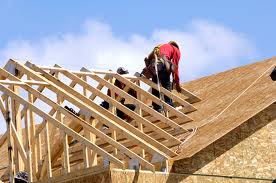-
On the surface, a roof looks like a simple covering on your home but it’s actually much more complex. The roof consists of layers of different materials designed to work together to keep wind, rain and other weather out of your home. Each layer has a purpose that, when combined with the others, helps protect your home.
Decking
- The decking on your roof is the base upon which everything else is laid. While the decking material can vary, most homes have plywood decking. The deck is nailed to the rafters creating the foundation of your roof.
Underlayment
- Underlayment is installed next onto the decking and most is most commonly felt. This felt is a durable paper that is saturated with asphalt. This is bottom most layer that provides an extra barrier against rain and wind, particularly in the event of broken or torn shingles.
Drip Edge
- The drip edge (also called flashing) consists of aluminum strips nailed into place at an angle. This flashing goes over the underlayment on the sides of the roof at the edges and beneath the underlayment at the eaves. This helps to prevent water from building up by guiding it over the eaves and into the gutters. Flashing is also used next to chimneys and other roof protrusions to help guide the water away from this opening in the roof deck and prevent it from entering your home. (try to find an image of a chimney with flashing)
Shingles
- Shingles can be asphalt, metal, clay or other material and they create the outer layer of your roofing system. When installed properly by a professional roofing contractor, your roof protects your home from all kinds of weather.
A properly installed roof will provide years of comfort and peace of mind knowing your home will be protected from the elements.
Roof Anatomy 101
Call Us Today at (407) 392-0218 for a Free Consultation!
"OUR BUSINESS IS ROOFING & REMODELING
OUR CONCERN IS YOUR WELFARE."
City Roofing and Remodeling
1606 East Central Blvd Orlando, FL 32803
PHONE: (407) 392-0218
cityroofingandremodeling@gmail.comFlorida Roofers License #CCC1330319
Florida General Contractors License #CGC1521712


